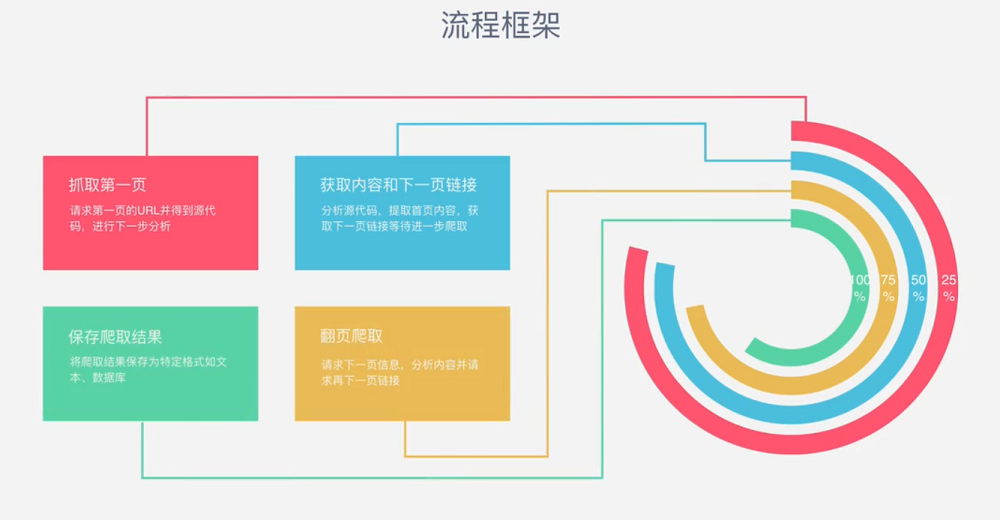Scrapy框架詳解及其基本使用
-
scrapy框架原理
Scrapy是一個為了爬取網站數據,提取結構性數據而編寫的應用框架。 其可以應用在數據挖掘,信息處理或存儲歷史數據等一系列的程序中。
其最初是為了頁面抓取 (更確切來說, 網絡抓取 )所設計的, 也可以應用在獲取API所返回的數據(例如 Amazon Associates Web Services ) 或者通用的網絡爬蟲。Scrapy用途廣泛,可以用于數據挖掘、監測和自動化測試。Scrapy 使用了 Twisted異步網絡庫來處理網絡通訊。整體架構大致如下

?

Scrapy主要包括了以下組件:
-
- 引擎(Scrapy)
用來處理整個系統的數據流處理, 觸發事務(框架核心) - 調度器(Scheduler)
用來接受引擎發過來的請求, 壓入隊列中, 并在引擎再次請求的時候返回. 可以想像成一個URL(抓取網頁的網址或者說是鏈接)的優先隊列, 由它來決定下一個要抓取的網址是什么, 同時去除重復的網址 - 下載器(Downloader)
用于下載網頁內容, 并將網頁內容返回給蜘蛛(Scrapy下載器是建立在twisted這個高效的異步模型上的) - 爬蟲(Spiders)
爬蟲是主要干活的, 用于從特定的網頁中提取自己需要的信息, 即所謂的實體(Item)。用戶也可以從中提取出鏈接,讓Scrapy繼續抓取下一個頁面 - 項目管道(Pipeline)
負責處理爬蟲從網頁中抽取的實體,主要的功能是持久化實體、驗證實體的有效性、清除不需要的信息。當頁面被爬蟲解析后,將被發送到項目管道,并經過幾個特定的次序處理數據。 - 下載器中間件(Downloader Middlewares)
位于Scrapy引擎和下載器之間的框架,主要是處理Scrapy引擎與下載器之間的請求及響應。 - 爬蟲中間件(Spider Middlewares)
介于Scrapy引擎和爬蟲之間的框架,主要工作是處理蜘蛛的響應輸入和請求輸出。 - 調度中間件(Scheduler Middewares)
介于Scrapy引擎和調度之間的中間件,從Scrapy引擎發送到調度的請求和響應。
- 引擎(Scrapy)
Scrapy運行流程大概如下:
1、從spider中獲取到初始url給引擎,告訴引擎幫我給調度器;
2、引擎將初始url給調度器,調度器安排入隊列;
3、調度器告訴引擎已經安排好,并把url給引擎,告訴引擎,給下載器進行下載;
4、引擎將url給下載器,下載器下載頁面源碼;
5、下載器告訴引擎已經下載好了,并把頁面源碼response給到引擎;
6、引擎拿著response給到spider,spider解析數據、提取數據;
7、spider將提取到的數據給到引擎,告訴引擎,幫我把新的url給到調度器入隊列,把信息給到Item Pipelines進行保存;
8、Item Pipelines將提取到的數據保存,保存好后告訴引擎,可以進行下一個url的提取了;
9、循環3-8步,直到調度器中沒有url,關閉網站(若url下載失敗了,會返回重新下載)。
-
基本使用
-
創建項目的基本過程
Scrapy:# 創建項目,在當前目錄中創建中創建一個項目文件(類似于Django) scrapy startproject sp1生成目錄如下:sp1- sp1- spiders 目錄,放置創建的爬蟲應用- middlewares.py 中間件- items.py 格式化,與pipelines.py一同做持久化- pipelines.py 持久化- settings.py 配置文件- scrapy.cfg 配置# 創建爬蟲應用 cd sp1scrapy genspider xiaohuar xiaohuar.com # 創建了xiaohuar.pyscrapy genspider baidu baidu.com # 創建了baidu.py# 展示爬蟲應用列表 scrapy list# 執行爬蟲,進入project scrapy crawl baiduscrapy crawl baidu --nolog
文件說明:

注意:一般創建爬蟲文件時,以網站域名命名
-
項目實戰
-
實戰目標:對目標站點所有語錄,作者,標簽進行爬取并存如MongoDB中
-
目標站點分析:Quates to scrape
-
流程框架:
-
爬蟲實戰
-
明確目標--->items.py(明確想要抓取的目標,定義需要爬取的信息(字段))
# -*- coding: utf-8 -*-import scrapy
class QuoteItem(scrapy.Item):# define the fields for your item here like:# name = scrapy.Field()text = scrapy.Field() #語錄內容author = scrapy.Field() #作者tags = scrapy.Field() #標簽 -
制作爬蟲--->quotes.py(解析數據,并提取信息和新的url)
# -*- coding: utf-8 -*- import scrapyfrom quotetutorial.items import QuoteItemclass QuotesSpider(scrapy.Spider):name = 'quotes'allowed_domains = ['quotes.toscrape.com']start_urls = ['http://quotes.toscrape.com/']def parse(self, response):#print(response.text)quotes = response.css('.quote') #獲取每行的全部信息for quote in quotes:item = QuoteItem() #創建獲取對象text = quote.css('.text::text').extract_first() #*::text 用于獲取文本信息,axtract_first() 用于獲得第一個文本信息*author = quote.css('.author::text').extract_first()tags = quote.css('.tags .tag::text').extract() #沒有指定獲取第一個--->獲取所有滿足條件的item['text'] = textitem['author'] = authoritem['tags'] = tagsyield itemnext = response.css('.pager .next a::attr(href)').extract_first() #獲取元素屬性信息url = response.urljoin(next) #把連接拼接起來yield scrapy.Request(url=url,callback=self.parse) #回調函數
-
存儲內容--->pipelines.py(設計管道存儲內容。當spider收集好Item后,會將Item(由字典組成的列表)傳遞到Item Pipeline,這些Item Pipeline組件按定義的順序處理Item)
# -*- coding: utf-8 -*- import pymongofrom scrapy.exceptions import DropItemclass TextPipeline(object): #對語錄進行處理,當長度超過50時,截斷然后在后面加*...*def __init__(self):self.limit =50def process_item(self, item, spider):if item['text']:if len(item['text']) > self.limit:item['text'] = item['text'][0:self.limit].rstrip() + '...'return itemelse:return DropItem('Miss Text')class MongoPipeline(object): #鏈接數據庫def __init__(self ,mongo_uri, mongo_db):self.mongo_uri = mongo_uriself.mongo_db = mongo_db@classmethoddef from_crawler(cls, crawler): #從ettings中拿到需要的配置信息(類方法)return cls(mongo_uri=crawler.settings.get('MONGO_URI'),mongo_db=crawler.settings.get('MONGO_DB'))def open_spider(self,spider): #初始化數據庫self.client = pymongo.MongoClient(self.mongo_uri)self.db = self.client[self.mongo_db]def process_item(self, item ,spider): #向數據庫插入數據name = item.__class__.__name__self.db[name].insert(dict(item))return itemdef close_spider(self ,spider):self.client.close()
-
相關配置--->settings.py(為了啟動Item Pipelines組件,必須將類添加到settings.py的ITEM_PIPELINES中,此處只有一個pipeline類,因此找到ITEM_PIPELINES,打開代碼)
# -*- coding: utf-8 -*-# Scrapy settings for quotetutorial project # # For simplicity, this file contains only settings considered important or # commonly used. You can find more settings consulting the documentation: # # https://doc.scrapy.org/en/latest/topics/settings.html # https://doc.scrapy.org/en/latest/topics/downloader-middleware.html # https://doc.scrapy.org/en/latest/topics/spider-middleware.html BOT_NAME = 'quotetutorial'SPIDER_MODULES = ['quotetutorial.spiders'] NEWSPIDER_MODULE = 'quotetutorial.spiders'MONGO_URI = 'localhost' MONGO_DB = 'quotestutorial'# Crawl responsibly by identifying yourself (and your website) on the user-agent #USER_AGENT = 'quotetutorial (+http://www.yourdomain.com)'# Obey robots.txt rules ROBOTSTXT_OBEY = True# Configure maximum concurrent requests performed by Scrapy (default: 16) #CONCURRENT_REQUESTS = 32# Configure a delay for requests for the same website (default: 0) # See https://doc.scrapy.org/en/latest/topics/settings.html#download-delay # See also autothrottle settings and docs #DOWNLOAD_DELAY = 3 # The download delay setting will honor only one of: #CONCURRENT_REQUESTS_PER_DOMAIN = 16 #CONCURRENT_REQUESTS_PER_IP = 16# Disable cookies (enabled by default) #COOKIES_ENABLED = False# Disable Telnet Console (enabled by default) #TELNETCONSOLE_ENABLED = False# Override the default request headers: #DEFAULT_REQUEST_HEADERS = { # 'Accept': 'text/html,application/xhtml+xml,application/xml;q=0.9,*/*;q=0.8', # 'Accept-Language': 'en', #}# Enable or disable spider middlewares # See https://doc.scrapy.org/en/latest/topics/spider-middleware.html #SPIDER_MIDDLEWARES = { # 'quotetutorial.middlewares.QuotetutorialSpiderMiddleware': 543, #}# Enable or disable downloader middlewares # See https://doc.scrapy.org/en/latest/topics/downloader-middleware.html #DOWNLOADER_MIDDLEWARES = { # 'quotetutorial.middlewares.QuotetutorialDownloaderMiddleware': 543, #}# Enable or disable extensions # See https://doc.scrapy.org/en/latest/topics/extensions.html #EXTENSIONS = { # 'scrapy.extensions.telnet.TelnetConsole': None, #}# Configure item pipelines # See https://doc.scrapy.org/en/latest/topics/item-pipeline.html ITEM_PIPELINES = {'quotetutorial.pipelines.TextPipeline': 300,'quotetutorial.pipelines.MongoPipeline': 400, }# Enable and configure the AutoThrottle extension (disabled by default) # See https://doc.scrapy.org/en/latest/topics/autothrottle.html #AUTOTHROTTLE_ENABLED = True # The initial download delay #AUTOTHROTTLE_START_DELAY = 5 # The maximum download delay to be set in case of high latencies #AUTOTHROTTLE_MAX_DELAY = 60 # The average number of requests Scrapy should be sending in parallel to # each remote server #AUTOTHROTTLE_TARGET_CONCURRENCY = 1.0 # Enable showing throttling stats for every response received: #AUTOTHROTTLE_DEBUG = False# Enable and configure HTTP caching (disabled by default) # See https://doc.scrapy.org/en/latest/topics/downloader-middleware.html#httpcache-middleware-settings #HTTPCACHE_ENABLED = True #HTTPCACHE_EXPIRATION_SECS = 0 #HTTPCACHE_DIR = 'httpcache' #HTTPCACHE_IGNORE_HTTP_CODES = [] #HTTPCACHE_STORAGE = 'scrapy.extensions.httpcache.FilesystemCacheStorage'
注意:如果有多個item pipelines的話(多種保存方式),需要在ITEM_PIPELINES中配置類,后面的“300”隨意設置。
? ?分配給每個類的整型值,確定了它們的運行順序。數值越低,組件的優先級越高,運行順序越靠前。
-
啟動項目:
scrapy crawl quotes
-
把獲得的內容保存
scrapy crawl quotes -o quotes.{json | jl | csv | xml | pickle | marshal}?
-
?




















